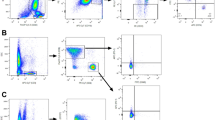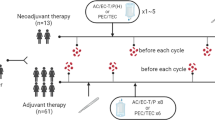Abstract
Purpose
Suppression of cellular immunity resulting from tumorigenesis and/or therapy might promote cancer cells’ growth, progression and invasion. Here, we explored whether T lymphocyte subtypes from peripheral blood of metastatic breast cancer (MBC) female patients could be used as alternative surrogate markers for cancer progress. Additionally, plasma levels of interleukin (IL)-2, IL-4, IL-6, IL-10, IFN-γ, and transforming growth factor-β1 were quantitated from MBC and healthy volunteers.
Experimental design
This study included 89 female MBC patients during the post-salvage chemotherapy follow-up and 50 age- and sex-matched healthy volunteers as control. The percentages of T lymphocyte subpopulations from peripheral blood and plasma levels of cytokines were measured.
Results
Both CD8+CD28− and CD4+CD25+ were elevated in MBC patients compared to the control cohort (P < 0.05). In contrast, CD3+ and CD8+CD28+cells were significantly lower in MBC patients (P < 0.0001, P = 0.045, respectively). MBC patients had elevated levels of immunosuppressive cytokines IL-6 and IL-10. Patients with elevated CD8+CD28− and CD4+CD25+ cells showed increased levels of IL-6, and only patients with elevated CD8+CD28− had decreased interferon-γ. Univariate analysis indicated increased CD3+CD4+ or CD8+CD28+correlated with prolonged progression-free survival (PFS), while elevated CD8+CD28−associated with shorten PFS. The percent of CD8+CD28− T lymphocytes is an independent predictor for PFS through multivariate analysis.
Conclusions
This study suggests that progressive elevated levels of CD8+CD28− suppressor T lymphocytes represent a novel independent predictor of PFS during post-chemotherapy follow-up.

Similar content being viewed by others
References
Marr LA, Gilham DE, Campbell JD, Fraser AR (2012) Immunology in the clinic review series; focus on cancer: double trouble for tumours: bi-functional and redirected T cells as effective cancer immunotherapies. Clin Exp Immunol 167(2):216–225
Chow MT, Möller A, Smyth MJ (2012) Inflammation and immune surveillance in cancer. Semin Cancer Biol 22(1):23–32
Shiao SL, Ganesan AP, Rugo HS, Coussens LM (2011) Immune microenvironments in solid tumors: new targets for therapy. Genes Dev 25(24):2559–2572
Leber MF, Efferth T (2009) Molecular principles of cancer invasion and metastasis. Int J Oncol 34(4):881–895
Miller FR (1993) Immune mechanisms in the sequential steps of metastasis. Crit Rev Oncog 4(3):293–311
Solomayer EF, Feuerer M, Bai L, Umansky V, Beckhove P, Meyberg GC, Bastert G, Schirrmacher V, Diel IJ (2003) Influence of adjuvant hormone therapy and chemotherapy on the immune system analyzed in the bone marrow of patients with breast cancer. Clin Cancer Res 9(1):174–180
Ceschia T, Beorchia A, Guglielmi R, Mandoliti G, Fongione S, Cereghini M, Tonutti E, Sala PG, Pizzi G (1991) Influence of radiotherapy on lymphocyte subpopulations. Radiol Med 81(4):532–536
Zou W (2006) Regulatory T cells, tumor immunity and immunotherapy. Nat Rev Immunol 6(4):295–307
Woo EY, Chu CS, Goletz TJ, Schlienger K, Yeh H, Coukos G et al (2001) Regulatory CD4+CD25+ T cells in tumors from patients with early-stage non-small cell lung cancer and late-stage ovarian cancer. Cancer Res 61(12):4766–4772
Ichihara F, Kono K, Takahashi A, Kawaida H, Sugai H, Fujii H (2003) Increased populations of regulatory T cells in peripheral blood and tumor-infiltrating lymphocytes in patients with gastric and esophageal cancers. Clin Cancer Res 9(12):4404–4408
Gilberto F, Filaci G, Fravega M, Negrini S, Procopio F, Fenoglio D et al (2004) Nonantigen specific CD8+ T suppressor lymphocytes originate from CD8+CD28− T cells and inhibit both T-cell proliferation and CTL function. Hum Immunol 65(2):142–156
Leong PP, Mohammad R, Ibrahim N, Ithnin H, Abdullah M, Davis WC et al (2006) Phenotyping of lymphocytes expressing regulatory and effector markers in infiltrating ductal carcinoma of the breast. Immunol Lett 102(2):229–236
Wang RF (2008) CD8 + regulatory T cells, their suppressive mechanisms, and regulation in cancer. Hum Immunol 69(11):811–814
Aandahl EM, Torgersen KM, Taskén K (2008) CD8+ regulatory T cells-A distinct T-cell lineage or a transient T-cell phenotype? Hum Immunol 69(11):696–699
Filaci G, Fenoglio D, Fravega M, Ansaldo G, Borgonovo G, Traverso P et al (2007) CD8+CD28− T regulatory lymphocytes inhibiting T cell proliferative and cytotoxic functions infiltrate human cancers. J Immunol 179(7):4323–4334
Melichar B, Tousková M, Solichová D, Králicková P, Kopecký G (2001) CD4 + T-lymphocytopenia and systemic immune activation in patients with primary and secondary liver tumours. Scand J Clin Lab Invest 61(5):363–370
Lissoni P, Brivio F, Ferrante R, Vigore L, Vaghi M, Fumagalli E et al (2000) Circulating immature and mature dendritic cells in relation to lymphocyte subsets in patients with gastrointestinal tract cancer. Int J Biol Markers 15(1):22–25
Melichar B, Jandik P, Krejsek J, Solichova D, Drahosova M, Skopec F et al (1996) Mitogen-induced lymphocyte proliferation and systemic immune activation in cancer patients. Tumori 82(3):218–220
Okita R, Saeki T, Takashima S, Yamaguchi Y, Toge T (2005) CD4 + CD25 + regulatory T cells in the peripheral blood of patients with breast cancer and non-small cell lung cancer. Oncol Rep 14(5):1269–1273
Meloni F, Morosini M, Solari N, Passadore I, Nascimbene C, Novo M et al (2006) Foxp3 Expressing CD4 + CD25 + and CD8 + CD28 − T Regulatory Cells in the Peripheral Blood of Patients with Lung Cancer and Pleural Mesothelioma. Hum Immunol 67(1–2):1–12
Fu J, Xu D, Liu Z, Shi M, Zhao P, Fu B et al (2007) Increased regulatory T cells correlate with CD8 T-cell impairment and poor survival in hepatocellular carcinoma patients. Gastroenterology 132(7):2328–2339
Holcombe RF, Jacobson J, Dakhil SR, Stewart RM, Betzing KS, Kannan K et al (1999) Association of immune parameters with clinical outcome in stage III colon cancer: results of Southwest Oncology Group Protocol 9009. Cancer Immunol Immunother 48(9):533–539
Zaloudik J, Lauerova L, Janakova L, Talac R, Simickova M, Nekulova M et al (1999) Significance of pre-treatment immunological parameters in colorectal cancer patients with unresectable metastases to the liver. Hepatogastroenterology 46(25):220–227
Vesely P, Tousková M, Melichar B (2005) Phenotype of peripheral blood leukocytes and survival of patients with metastatic colorectal cancer. Int J Biol Markers 20(2):126–133
Liu F, Lang R, Zhao J, Zhang X, Pringle GA, Fan Y et al (2011) CD8+ cytotoxic T cell and FOXP3+ regulatory T cell infiltration in relation to breast cancer survival and molecular subtypes. Breast Cancer Res Treat 130(2):645–655
Tiwari M (2010) From tumor immunology to cancer immunotherapy: miles to go. J Cancer Res Ther 6(4):427–431
Duray A, Demoulin S, Hubert P, Delvenne P, Saussez S (2010) Immune suppression in head and neck cancers: a review. Clin Dev Immunol. doi:10.1155/2010/701657
Kim R, Emi M, Tanabe K, Arihiro K (2006) Tumor-driven evolution of immunosuppressive networks during malignant progression. Cancer Res 66(11):5527–5536
Suzuki K, KadotaK Sima CS, Nitadori J, Rusch VW, Travis WD et al (2013) Clinical impact of immune microenvironment in stage I lung adenocarcinoma: tumor interleukin-12 receptor β2(IL-12Rβ2), IL-7R, and stromal FoxP3/CD3 ratio are independent predictors of recurrence. J Clin Oncol 31(4):490–498
Saison J, Demaret J, Venet F, Chidiac C, Malcus C, Poitevin-Later F et al (2013) CD4+CD25+CD127- assessment as a surrogate phenotype for FOXP3+ regulatory T cells in HIV-1 infected viremic and aviremic subjects. Cytometry B Clin Cytom 84(1):50–54
Wang HY, Wang RF (2007) Regulatory T cells and cancer. Curr Opin Immunol 19(2):217–223
Watanabe MA, Oda JM, Amarante MK, Cesar Voltarelli J (2010) Regulatory T cells and breast cancer: implications for immunopathogenesis. Cancer Metastasis Rev 29(4):569–579
Sakaguchi S (2005) Naturally arising Foxp3-expressing CD25 + CD4 + regulatory T cells in immunological tolerance to self and nonself. Nat Immunol 6(4):345–352
Shevach EM (2002) CD4 + CD25 + suppressor T cells: more questions than answers. Nat Rev Immunol 2(6):389–400
Chen W, Jin W, Hardegen N, Lei KJ, Li L, Marinos N et al (2003) Conversion of peripheral CD4 + CD25– naive T cells to CD4 + CD25 + regulatory T cells by TGF-beta induction of transcription factor Foxp3. J Exp Med 198(12):1875–1886
Liyanage UK, Moore TT, Joo HG, Tanaka Y, Herrmann V, Doherty G et al (2002) Prevalence of regulatory T cells is increased in peripheral blood and tumor microenvironment of patients with pancreas or breast adenocarcinoma. J Immunol 169(5):2756–2761
Sasada T, Kimura M, Yoshida Y, Kanai M, Takabayashi A (2003) CD4 + CD25 + regulatory T cells in patients with gastrointestinal malignancies: possible involvement of regulatory T cells in disease progression. Cancer 98(5):1089–1099
Javia LR, Rosenberg SA (2003) CD4 + CD25 + suppressor lymphocytes in the circulation of patients immunized against melanoma antigens. J Immunother 26(1):85–93
Somasundaram R, Jacob L, Swoboda R, Caputo L, Song H, Basak S et al (2002) Inhibition of cytolytic T lymphocyte proliferation by autologous CD4 + CD25 + regulatory T cells in a colorectal carcinoma patient is mediated by transforming growth factor. Cancer Res 62(18):5267–5272
Kim R, Emi M, Tanabe K (2006) Cancer immunosuppression and autoimmune disease: beyond immunosuppressive networks for tumour immunity. Immunology 119(2):254–264
Qiu YR, Yang CL, Chen LB, Wang Q (2002) Analysis of CD8(+) and CD8(+)CD28(−) cell subsets in patients with hepatocellular carcinoma. Di Yi Jun Yi Da Xue Xue Bao 22(1):72–73
Tsukishiro T, Donnenberg AD, Whiteside TL (2003) Rapid turnover of the CD8(+)CD28(−) T-cell subset of effector cells in the circulation of patients with head and neck cancer. Cancer Immunol Immunother 52(10):599–607
Strioga M, Pasukoniene V, Characiejus D (2011) CD8 + CD28- and CD8 + CD57 + Tcells and their role in health and disease. Immunology 134(1):17–32
Pagès F, Berger A, Camus M, Sanchez-Cabo F, Costes A, Molidor R et al (2005) Effector memory T cells, early metastasis, and survival in colorectal cancer. N Eng J Med 353(25):2654–2666
Karagöz B, Bilgi O, Gümüs M, Erikçi AA, Sayan O, Türken O et al (2010) CD8 + CD28- cells and CD4 + CD25 + regulatory T cells in the peripheral blood of advanced stage lung cancer patients. Med Oncol 27(1):29–33
DeBenedette MA, Calderhead DM, Tcherepanova IY, Nicolette CA, Healey DG (2011) Potency of mature CD40L RNA electroporated dendritic cells correlates with IL-12 secretion by tracking multifunctional CD8(+)/CD28(+) cytotoxic T-cell responses in vitro. J Immunother 34(1):45–57
Acknowledgments
The authors thank Dr. Wei Sun for excellent technical assistance in flow cytometric analysis, Amy Hobeika Ph.D. from Duke university medical center, Durham, NC, USA for assistance with language editing. Authors received financial support from Natural Science Foundation of China (No.81172534) and Komen-Duke Project in China (3833989) from Susan G. Komen for the Cure Foundation.
Conflict of interest
No potential conflict of interests were disclosed.
Author information
Authors and Affiliations
Corresponding authors
Rights and permissions
About this article
Cite this article
Song, G., Wang, X., Jia, J. et al. Elevated level of peripheral CD8+CD28− T lymphocytes are an independent predictor of progression-free survival in patients with metastatic breast cancer during the course of chemotherapy. Cancer Immunol Immunother 62, 1123–1130 (2013). https://doi.org/10.1007/s00262-013-1424-8
Received:
Accepted:
Published:
Issue Date:
DOI: https://doi.org/10.1007/s00262-013-1424-8




